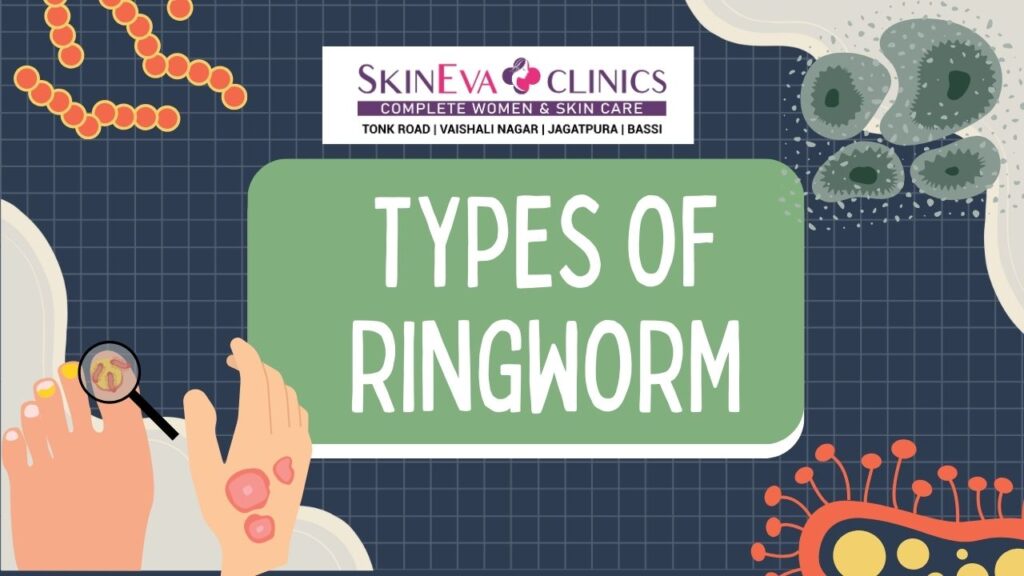Different Types of Ringworm

Ringworm (tinea) is a frequent fungal disease affecting areas like the scalp, skin, and nails. Its name can be misleading since it has nothing to do with worms; instead, it develops due to dermatophyte fungi that flourish in moist environments. Because of its contagious nature, it can pass on through skin contact, sharing items, or exposure to infected animals.
Ringworm is a condition we often treat, and it can appear in different forms depending on which part of the body is affected. Each type of ringworm has its own signs and symptoms, and recognizing these early helps in getting the right treatment.
Let’s look at the major types of ringworm and how they present:
1. Tinea Corporis (Body Ringworm)
This is the most recognizable form of ringworm and can appear anywhere on the body, especially the arms, legs, chest, and back.
- Appearance: Ring-shaped, red, scaly patches with a clear center and slightly raised edges.
- Symptoms: Persistent itching, irritation, and sometimes overlapping rings as the rash expands.
- Key Point: If untreated, the infection may spread rapidly across large areas of skin.
2. Tinea Capitis (Scalp Ringworm)
Scalp ringworm is seen more frequently in kids, yet it can occasionally be found in adults as well.
- Appearance: Scaly bald patches, sometimes dotted with broken hairs. In severe cases, pus-filled sores may develop.
- Symptoms: Itching, tenderness, hair breakage, and occasionally swollen lymph nodes.
- Key Point: This type often requires oral antifungal medication since topical creams cannot penetrate deep into hair follicles.
3. Tinea Pedis (Athlete’s Foot)
A very widespread form of ringworm, especially among people who wear closed shoes for long hours.
- Appearance: Peeling, cracked skin between the toes or on the soles; sometimes red, raw, or blistered.
- Symptoms: Burning, itching, foul odor, and discomfort while walking.
- Risk Factors: Sweaty feet, damp socks, walking barefoot in communal spaces.
- Key Point: Athlete’s foot can easily spread to the toenails or hands if not treated properly.
4. Tinea Cruris (Jock Itch)
This form affects the groin, inner thighs, and buttocks, and is more common in men.
- Appearance: Red or brown patches with defined edges, often shaped like a half-moon.
- Symptoms: Persistent itching, irritation, and rash that worsens with heat and sweat.
- Key Point: Wearing loose, breathable clothing can reduce recurrence along with treatment.
5. Tinea Unguium (Onychomycosis / Nail Fungus)
A stubborn type of ringworm that affects fingernails and toenails.
- Appearance: Nails become thick, yellowish, brittle, and may crumble at the edges.
- Symptoms: Pain, difficulty trimming nails, and embarrassment due to appearance.
- Key Point: Nail infections usually take months to fully heal and often need oral medication.
6. Tinea Barbae (Beard Ringworm)
Primarily affecting men, this type involves the beard and mustache area.
- Appearance: Inflamed, scaly patches, sometimes with pustules (small pus-filled bumps).
- Symptoms: Itching, swelling, tenderness, and patchy hair loss.
- Key Point: Beard ringworm may spread by contaminated razors or through contact with infected animals.
7. Tinea Manuum (Hand Ringworm)
Hand ringworm is frequently linked with foot infections and can spread from scratching.
- Appearance: Very dry, thickened skin on the palms or circular rashes on the back of the hands.
- Symptoms: Itching, redness, cracking, and sometimes nail involvement.
- Key Point: Often misdiagnosed as eczema or dermatitis, so medical evaluation is important.
8. Tinea Faciei (Facial Ringworm)
This type appears on areas of the face that don’t include the beard.
- Appearance: Red, scaly patches that may worsen in sunlight.
- Symptoms: Mild itching, irritation, and sometimes burning.
- Key Point: Because it resembles other skin problems, getting the right diagnosis is very important.
9. Emerging and Resistant Forms of Ringworm
In recent years, resistant strains of ringworm have been reported, making treatment more challenging. In rare situations, the fungus can also spread through intimate contact. These cases highlight why self-treatment is not always effective and why medical guidance matters.
Why Timely Treatment Matters
Ringworm may start small, but it rarely goes away on its own. Left untreated, it can:
- It can spread further across the body.
- Pass on to family members, friends, or pets.
- Become harder to treat if resistant strains develop.
Over-the-counter antifungal products often work for minor skin infections, but nail and scalp cases typically require stronger prescription drugs. Preventing recurrence involves proper hygiene, keeping skin dry, and avoiding shared items.
Conclusion
Ringworm can affect anyone — children, adults, athletes, or pet owners. While the condition is uncomfortable and sometimes embarrassing, the good news is that it’s completely treatable with the right care.
By recognizing the different types of ringworm and seeking timely treatment, you can stop the infection early, avoid complications, and protect your loved ones from catching it too.



Leave a Comment